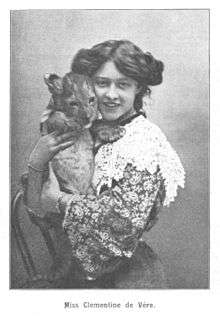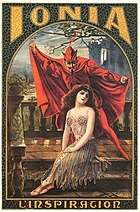Clémentine de Vère
Clémentine Lisine de Vère (20 December 1888–31 March 1973) was a British magician and illusionist. Also known as Clementine de Vere and Princess Clémentine Eristavi Tchitcherine, she was a British citizen, although she was born in Belgium and lived in France for a long period. She became known under the stage name "Ionia - the Enchantress" or the "Goddess of Mystery".[1]

Early years
Born in Brussels in Belgium,[2][3] Clémentine Lisine de Vère was the eighth child of the British-born illusionist Herbert Shakespeare Gardiner Williams (1843-1931),[2] a popular conjurer and magician who took the stage name Charles de Vère, and his wife Julia de Vère (née Ferrett, 1852-1916),[2] who performed the first Oriental magic act under the name "Okita".[4][5][6] He opened a magic shop in London in 1873, and a magic shop/factory in Brussels in 1878. One of Clémentine's sisters was the French actress Élise de Vère (1879-1917). The family moved to Paris in 1892 where Charles de Vère opened another magic shop which he ran until about 1909, assisted by his sons. Here Clémentine de Vère was said to have been influenced by the artists of the Folies Bergère. On 5 May 1904 aged only 15 she eloped with and married the American circus artist and tamer Herman Weedon (actually: Herman Armond Wirtheim, 1876-1959) from the Bostock Circus.[7][8]
In June 1904 the newly-married couple travelled to New York as Weedon had a commitment on Coney Island. It is possible that she accompanied him in the following years on his professional travels, which also took him to Egypt and the Belgian Congo. From her marriage with Weedon she had a son, Frank H. Weedon (1907-1984),[7] who later was known under the name Frank Wirtheim Tchitcherine. It would appear that Clémentine de Vère did not travel with Weedon in 1909, but she and her brother Camille (1885-1909) were working in their father's magic business in Paris until Camille died of diabetes mellitus. Charles de Vère then gave up his business and retired to Rosny-sous-Bois, where he apparently worked on the preparation of a big show for his daughter.
"Ionia"

On 30 January 1911 she appeared on stage for the first time as "Ionia", later sometimes billed as "the Enchantress" or as the "Goddess of Mystery", in an act at the Birmingham Hippodrome in England in a routine which required six tons of equipment and elaborate Egyptian costumes for Clémentine and her male and female assistants.[1][7][9][10] "Ionia" had great success and that year her act was seen in Vienna, Berlin, Paris and other venues. Her last contemporary mention was apparently in the March 1911 issue of the magazine The Sphinx the cover of which showed a photograph de Vère. The text in this issue dealt with her appearance in Manchester.
The sudden disappearance of "Ionia" from the stage may have been related to the closure of the Folies Bergere of New York. This theatre was opened in the spring of 1911 and had to close again in October of the same year because of financial difficulties. Apparently Clémentine de Vère had a contract with this theatre and after its closure could not find suitable employment.[11]
The last recorded appearance of Clémentine de Vère as "Ionia" was in Vienna, this time in a pantomime. Following this Charles de Vère was disappointed that his daughter had not continued her elaborate act and tried to sell the tricks and pieces of equipment to curb the financial losses that had arisen for him.[12]
Marriage and divorce

She met a Russian-Georgian Prince Vladimir Eristavi Tchitcherine in Austria in 1913 and married him on 21 June 1919 in Paris, after her first marriage had been dissolved on 23 June 1917.[7][8] The claim of her father that she had stayed in Moscow during the Russian Revolution appears to be untrue. In the 1920s Clémentine de Vère lived temporarily with her second husband in Washington, DC and later in Paris. On 26 October 1928 this second marriage too was dissolved, but Clémentine de Vère retained the title of Princess, which she had received by the marriage. She lived in Monaco and France for the rest of her life and was buried next to her parents in Batignolles Cemetery in Paris, France after her death in 1973.[7]
Although her stage career was relatively short, lasting just three years, "Ionia's" act was spectacular, filling the stage with illusions. Her act was advertised with beautiful posters which many collectors consider to be some of the most artistic posters of magic’s “Golden Age.” Of the 22 known posters for "Ionia" produced by Moody Brothers of Birmingham, only about nine have survived and are now considered expensive collectibles.[13][14]
References
- Remarkable Archive Relating to an Acclaimed Female Illusionist of the Early 20th Century, Known as Ionia The Enchantress - Martayan Lan
- 1891 Census Record for Clémentine de Vère - Ancestry.com (subscription required)
- 1911 Census Record for Clémentine Weedon - Ancestry.com (subscription required)
- Charles De Vere (1843 - 1931), par Louis Tummers in L'Escamoteur No. 62-91, TREIZIÈME ANNÉE N° 76 MAI-JUIN 1959, page 1 211
- A Rich Cabinet of Magical Curiosities by Edwin Dawes #222. Hohn Kawrence Toole in Magic Circular Vol. 90, No. 966 July 1996, page 104
- 'Geschichte der Zauberkunst', von Kurt Volkmann, 74. Folge, in Magie (German Magic Circle), Issues 1951 - 1958
- Clémentine de Vère on Magic Tricks website
- Erin Morgenstern, The Night Circus, Vintage, (N.D) - Google Books
- "Ionia" on Magic Poster Gallery
- Amy Dawes (2007) The Female of the Species, Early Popular Visual Culture, 5:2, 127-150, DOI: 10.1080/17460650701433780
- Greene, p 73
- Charles Greene III, 'Ionia. The Queen of Mystery' Magic, December 2006, p. p. 70
- Ionia "The Enchantress" - All About Magicians website
- Sale of a poster advertising Clementine de Vere - Ionia - L’Enchantresse
Bibliography
- Charles Greene III, 'Ionia. The Queen of Mystery', Magic, December 2006, p. 68 ff.